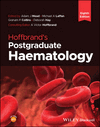Consultative haemostasis and thrombosis
Michael A Laffan
Department of Immunology and Inflammation, Faculty of Medicine, Imperial College London, London, UK
Search for more papers by this authorPeter MacCallum
Haematology, Wolfson Institute of Population Health, Faculty of Medicine and Dentistry, Queen Mary University of London, London, UK
Search for more papers by this authorMichael A Laffan
Department of Immunology and Inflammation, Faculty of Medicine, Imperial College London, London, UK
Search for more papers by this authorPeter MacCallum
Haematology, Wolfson Institute of Population Health, Faculty of Medicine and Dentistry, Queen Mary University of London, London, UK
Search for more papers by this authorAdam J Mead PhD, FRCP, FRCPath, FMedSci
Haematopoietic Stem Cell Biology Laboratory, Medical Research Council Molecular Haematology Unit, Medical Research Council Weatherall Institute of Molecular Medicine, University of Oxford, Oxford, UK
Search for more papers by this authorMichael A Laffan DM, MRCP, FRCPath
Department of Immunology and Inflammation, Faculty of Medicine, Imperial College London, London, UK
Search for more papers by this authorGraham P Collins DPhil, FRCP, FRCPath
Department of Haematology, Oxford Cancer and Haematology Centre, Oxford, UK
Search for more papers by this authorDeborah Hay DPhil, MRCP, FRCPath
Nuffield Division of Clinical Laboratory Sciences, Radcliffe Department of Medicine, University of Oxford, Oxford, UK
Search for more papers by this authorA Victor Hoffbrand MA, DM, FRCP, FRCPath, FRCP (Edin), DSc, FMedSci
Emeritus Professor of Haematology Honorary Consultant Haematologist
University College London, London, UK
Royal Free Hospital, London, UK
Search for more papers by this authorSummary
Much of haematology work is consultative and this is particularly true of thrombosis and haemostasis. Many other disciplines treat disorders, use therapies or perform procedures that increase the risk of bleeding or thrombosis and many patients take anticoagulants which increase the risks further. Resolving the different elements of risk and benefit by the haematologist, to provide a balanced assessment of the best management, is an important role because other clinical teams may focus only on aspects of the problem related to their specialty. Good consultation therefore requires awareness of congenital and acquired disorders, therapies and short- and long-term risk, as well as using results of laboratory and near patient testing devices. Consultation may also require repeated visits to recognise trends in treatment and changes in priority. This chapter offers practical approaches to these problems both in the acute in hospital setting and also for outpatients.
Selected bibliography
- Arachchillage DR , Gomez K , Alikhan R et al . ( 2020 ) Addendum to the British Society for Haematology Guidelines on the investigation and management of antiphospholipid syndrome, 2012 (Br J Haematol 2012: 157 : 47–58): use of direct acting oral anticoagulants . British Journal of Haematology 189 : 212 – 5 .
- Arachchillage DR , Laffan M ( 2020 ) What is the appropriate anticoagulation strategy for thrombotic antiphospholipid syndrome . British Journal of Haematology 189 : 216 – 27 .
- Baharoglu MI , Cordonnier C , Salman Rustam Al-Shahi et al . ( 2016 ) Platelet transfusion versus standard care after acute stroke due to spontaneous cerebral haemorrhage associated with antiplatelet therapy (PATCH): a randomised open-label, phase 3 trial . Lancet 387 : 2605 – 13 .
-
Biss T
,
Sibson K
,
Baker P
et al
. (
2022
)
Haematological evaluation of bruising and bleeding in children undergoing child protection investigation for possible physical maltreatment: a British Society for Haematology Good Practice Paper
.
British Journal of Haematology
199
:
1
–
9
.
https://doi.org/10.1111/bjh.18361
.
10.1111/bjh.18361 Google Scholar
- Curry NS , Davenport R , Pavord S et al . ( 2018 ) The use of viscoelastic haemostatic assays in the management of major bleeding . British Journal of Haematology 182 : 789 – 806 . https://doi.org/10.1111/bjh.15524 .
- Hatemi G , Christensen R , Bang D et al . ( 2018 ) 2018 update of the EULAR recommendations for the management of Behçet's syndrome . Annals of the Rheumatic Diseases 77 : 808 – 18 .
- Keeling D , Campbell Tait R , Watson H ( 2016 ) Peri-operative management of anticoagulation and antiplatelet therapy . British Journal of Haematology 175 : 602 – 13 .
- Kuramatsu JB , Sembill JA , Gerner ST et al . ( 2018 ) Management of therapeutic anticoagulation in patients with intracerebral haemorrhage and mechanical heart valves . European Heart Journal 39 : 1709 – 23 .
- Levy JH , Connors JM ( 2021 ) Heparin resistance – clinical perspectives and management strategies . The New England Journal of Medicine 385 : 826 – 32 .
- Saja K ; on behalf of the Haemostasis and Thrombosis Taskforce of the British Society for Haematology ( 2022 ) Addendum to the guideline on the peri-operative management of anticoagulation and antiplatelet therapy . British Journal of Haematology 197 : 188 – 9 .
- Shet AS , Lizarralde-Iragorri MA , Naik RP et al . ( 2020 ) The molecular basis for the prothrombotic state in sickle cell disease . Haematologica 105 : 2368 – 79 .
- Schulman S. ( 2017 ) How I treat recurrent venous thromboembolism in patients receiving anticoagulant therapy . Blood 129 : 3285 – 93 .
- Sprigg N , Flaherty K , Appleton JP et al . ( 2018 ) Tranexamic acid for hyperacute primary IntraCerebral Haemorrhage (TICH-2): an international randomised, placebo-controlled, phase 3 superiority trial . Lancet 391 : 2107 – 15 .
- Steffel J , Heidbüchel H ( 2021 ) 2021 European Heart Rhythm Association Practical Guide on the use of non-vitamin K antagonist oral anticoagulants in patients with atrial fibrillation . Europace 23 : 1612 – 76 .
- Zwicker JI , Wang T-F , DeAngelo DJ et al . ( 2020 ) The prevention and management of asparaginase-related venous thromboembolism in adults: Guidance from the SSC on Hemostasis and Malignancy of the ISTH . Journal of Thrombosis and Haemostasis 18 : 278 – 84 .



